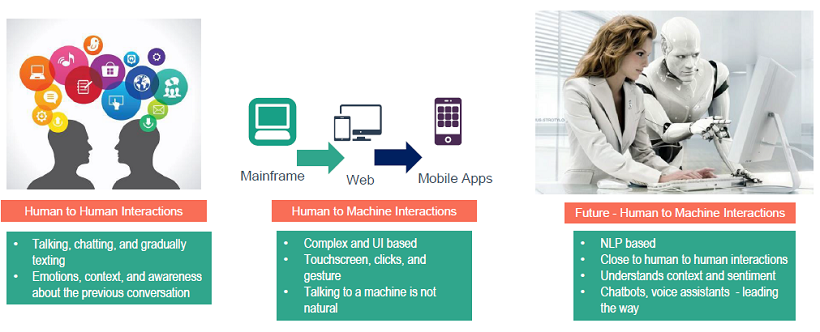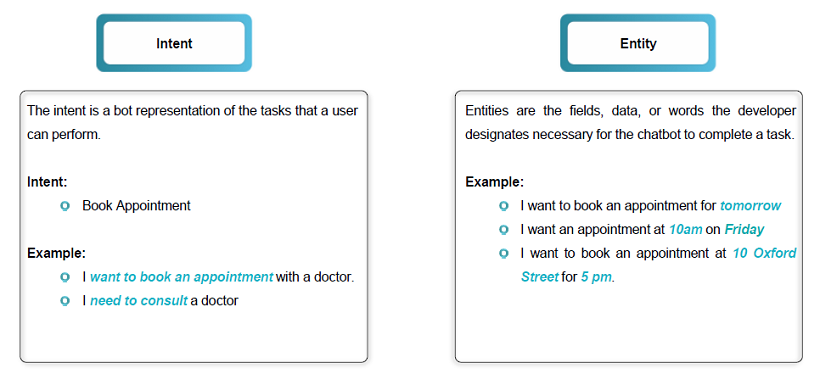- Chatbot Overview
- Release Notes
- Bot Builder
-
- Creating a Bot
- Storyboard
- Dialog Task
- Alert Tasks
- Digital Forms
- Digital Views
- Knowledge Graph
- Knowledge Extraction
- Small Talk
- Action & Information Task
- Natural Language
- Bot Intelligence
- Channel Enablement
- Test & Debug
- Publishing your Bot
- Analyzing your Bot
- Advanced Topics
- Bot Settings
- API Guide
- SDKs
- Bot Administration
- How Tos
-
- Creating a Simple Bot
- Creating a Banking Bot
- Context Switching
- Using Traits
- Schedule a Smart Alert
- Configure Digital Forms
- Add Form Data into Data Tables
- Configuring Digital Views
- Add Data to Data Tables
- Update Data in Data Tables
- Custom Dashboard
- Custom Tags to filter Bot Metrics
- Patterns for Intents & Entities
- Build Knowledge Graph
- Global Variables
- Content Variables
- Using Bot Functions
- Configure Agent Transfer
- Chatbot Overview
- Release Notes
- Bot Builder
-
- Creating a Bot
- Storyboard
- Dialog Task
- Alert Tasks
- Digital Forms
- Digital Views
- Knowledge Graph
- Knowledge Extraction
- Small Talk
- Action & Information Task
- Natural Language
- Bot Intelligence
- Channel Enablement
- Test & Debug
- Publishing your Bot
- Analyzing your Bot
- Advanced Topics
- Bot Settings
- API Guide
- SDKs
- Bot Administration
- How Tos
-
- Creating a Simple Bot
- Creating a Banking Bot
- Context Switching
- Using Traits
- Schedule a Smart Alert
- Configure Digital Forms
- Add Form Data into Data Tables
- Configuring Digital Views
- Add Data to Data Tables
- Update Data in Data Tables
- Custom Dashboard
- Custom Tags to filter Bot Metrics
- Patterns for Intents & Entities
- Build Knowledge Graph
- Global Variables
- Content Variables
- Using Bot Functions
- Configure Agent Transfer
チャットボットの概要
コミュニケーションは時代の初めから生活の本質でした。 テクノロジーの進化により、コミュニケーションの方法やスタイルも進化してきました。
初期の頃は、会話は人間同士の言葉や文字による交流に限られていました。 これらの交流は、通常、感情、文脈、および前の会話の認識によって導かれます。 コンピュータの出現により、交流は機械、すなわち人間と機械の交流を含むまでに拡大してきました。 コマンドベースのインターフェイスからグラフィカルユーザーインターフェイス(GUI)から会話型ユーザーインターフェイス(CUI)への移行は自然で、ニーズに基づいたものであり、この移行によってコミュニケーションが容易になりました。
CUIによって、自然な言語でユーザーと対話することができるチャットボットが登場しました。 人工知能とNLPの機能をさらに強化することで、チャットボットは自然言語でユーザーの発話を理解し、ユーザーの発話からタスクを導き出し、タスクを正常に実行するために必要な情報を抽出することができるようになりました。
AIを駆使したNLPベースのチャットボットや音声アシスタントは、最新のテクノロジーであり、最近ではすべてのビジネスに欠かせないものとなっています。

会話型ボットとは
チャットボットは、ヒト、デジタルシステム、インターネット対応のモノの間のインテリジェントな仲介役として機能する仮想アシスタントと定義できます。 アプリケーションやWebサイトの従来のグラフィカルユーザーインターフェイス(GUI)を「会話型ユーザーインターフェイス」に置き換えます。 これは、構文固有のコマンドを入力するか、アイコンをクリックすることで達成される以前の通信からのパラダイムシフトです。
チャットボットは、自然言語ベースの会話をミックスして人々とチャットするように設計することができ、応答はボタン、カレンダー、または人の応答速度を加速させる他のウィジェットの形で提供することができます。
この未来への第一歩として、AIを活用したメッセージングソリューションや会話型ボットがあります。 会話型ボットとは、インテリジェントなバーチャルエージェント、組織のアプリ、組織のWebサイト、ソーシャルプラットフォーム、メッセンジャープラットフォームなど、さまざまなデジタルメディアを介してコミュニケーションを取ることに優れた、自動的に動作するコンピュータプログラムのことです。 ユーザーは、音声やテキストを使ってこのようなボットと対話し、情報にアクセスしたり、タスクを完了させたり、取引を実行したりすることができます。
では、会話型ボットの特徴は何でしょうか? 簡単に言うと、
インテントとエンティティとは
会話型ボットは、3つの課題に直面しています。
- ⦁ ユーザーが何を望んでいるかを理解する – インテント検出
- ⦁ ユーザーが望むことを達成するために、ユーザーから必要な情報を抽出する – エンティティ抽出
- ⦁ ユーザーの要望を達成する – 会話/ダイアログフロー。
ユーザーが何を言っても発言とみなされます。 このユーザの発言から、会話を進めるために必要なインテントとエンティティを抽出するのが会話型ボットの仕事です。 この記事の残りの部分では、次のようなユーザーの発言を考えてみます。「今週末ロンドンに飛びたい」
インテントとは、ユーザーの意図のことです。 これは通常、ユーザーの発言の中で動詞や名詞の形で出てきます。 上記のユーザー発言から、会話ボットはユーザーの意図を「飛びたい」と理解し、対応するダイアログタスクをトリガーします。
エンティティとは、ユーザーの意図で特定されたタスクを完了するためにボットが必要とするデータや情報の断片のことです。 ボットに必要なさまざまな形式のエンティティが複数存在する場合があります。 これらは、ユーザーの発言の一部として使用することも、ボットがユーザーにエンティティ値の入力を求める必要があることもあります。 例えば、上記のユーザー発言では、「ロンドン」と「今週末」は、それぞれ目的地と旅行日というエンティティの値を形成しています。 ご覧のように、「ソース」エンティティの値が欠落しているため、ボットは同じ値を入力するようにユーザーに要求する必要があります。
インテリジェントボットの構築方法
ボットはデフォルトではスマートではありません。 ボットは機械学習、ビッグデータ、自然言語処理などの技術を活用して、ある程度の人工知能を発揮できるように作られています。 チャットボットは、ユーザーのニーズを認識し、ユーザーの視点や文脈を理解し、ユーザーの気分や感情に応じて応答することで、インテリジェントなものとなります。 その知能の高さが、チャットボットに会話のあらゆるシナリオを簡単に処理する能力を与えているのです。
人間を理解するための会話型ボットの鍵は、人間の意図を特定し、ユーザーの話し手から関連情報を抽出し、その行為に関連する行動やタスクをマッピングする能力です。 NLP(自然言語処理)とは、テキストの意図(インテント)と関連情報(エンティティ)をテキストから抽出する科学です。
対話を管理して複数の会話スレッドを追跡し、コンテキストを記憶し、ユーザーの声や感情に反応することで、会話に必要な人間的なタッチを与えると同時に、ユーザーに正確で適切な応答を提供することができます。
インテリジェントなボットを構築するのに役立つもう一つの側面は、ナレッジベースを持つことです。 これにより、ボットはよくある質問に静的な応答を返すことができるようになります。 ナレッジコレクションを構築することは、カテゴリーのシステムに従って、相互に依存するすべての特性と関係を持つエンティティ、アイデア、およびイベントを表現する試みです。 この構造化されたデータ分類は、ボットがユーザーのクエリに効果的かつ容易に応答するのに役立ちます。



